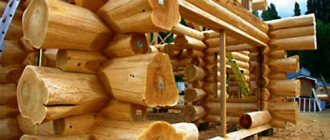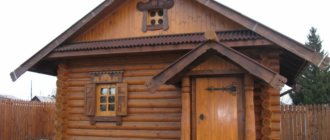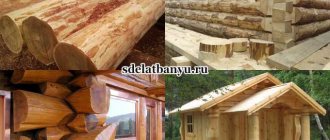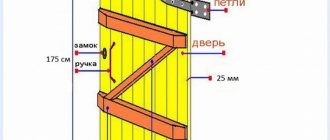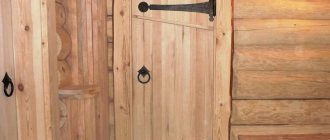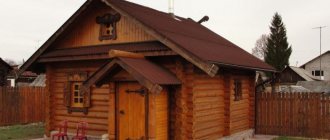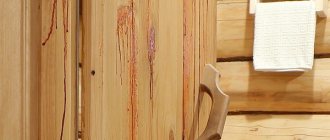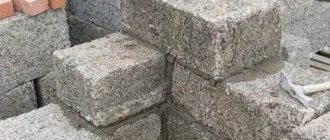Fans of hot steam, dry or wet, take the arrangement of their home bathhouse extremely seriously. Due to the special specifics of the building, each of its elements must fully meet fairly stringent requirements in order for the bathhouse to be comfortable and durable. For example, the choice of doors plays an important role: should you install a traditional solid wood door or should you give preference to modern plastic? If we know almost everything about how wooden doors behave in a bathhouse, then it’s worth talking about plastic doors in more detail. And we should start by considering the pros and cons of plastic.
PVC doors
A PVC door is a complex product consisting of a doorway or frame, door leaf, fittings and double-glazed windows. The plastic from which the product is assembled has a metal profile , which imparts rigidity to the structure. To retain heat, the plastic profile has a structure with cells, or so-called chambers. The air cushion in the chamber slows down the heating or cooling of the profile. The more cameras in a profile, the higher its energy efficiency. A standard PVC profile contains from 3 to 5 chambers. Profile thickness 58 mm . There are also systems with a thickness of 70 mm (recommended for use in external structures) and 90 mm (used in low temperature conditions and are present in a limited range on the market). Thus, the optimal choice would be a profile with a thickness of 58 mm .
The door leaf is also assembled from a plastic profile and differs in types of glazing.
Device
Bath doors also differ in their design. Let's find out more about the most popular options.
- The following types of doors are reliable and wear-resistant: wedge doors with a solid leaf, glued into a micro-tenon groove, and also with two wedges that secure the boards well. This type of assembly prevents the possible appearance of cracks and deformation of products in difficult bath conditions.
- Paneled with several components - door leaf, frame, platbands and extensions. No less popular options found in many baths.
- Sliding and swing door panels are in demand these days. They can be equipped with a special roller system that allows the structures to be opened and closed without hindrance. The sliding door is usually placed inside the bathhouse and does not serve as an entrance part.
Types of glazing of plastic doors
- Solid . The glass unit occupies a large area of the door. At the customer's request, one solid glass unit can be used, or the door leaf can be divided into two or more parts.
- Combined . The upper part of the door has double glazed windows. In the lower part, a light-proof sandwich panel is installed in place of the double-glazed window.
- No glazing . A sandwich panel is mounted in the standard place under the double-glazed window.
Thermal curtain
The easiest way to insulate a bath door is a thermal curtain. The use of this material requires minimal time and effort. Such insulation of doors in a bathhouse also requires adherence to a certain technology:
- The first step is to form a compacted frame - the simplest way to thermally insulate the insulation of a door. At the same time, do not forget that the strips of material for sealing the opening are attached at a distance of at least 2 cm from the edge.
- Long and short bars are wrapped with insulating material, after which they are nailed at the entrance. As a result, you should end up with an even rectangle.
- Next, a thermal curtain of the required size is made from canvas fabric or leatherette.
- The right side of the fabric is attached to the wall, the edge itself is attached to a wooden batten. At least 8 rings are installed on the top.
- Self-tapping screws are attached to the upper sides of the frame, which will become the basis for wire or nylon cord. Once completed, the cord is threaded through the rings. This method of improving heat retention in a building is accessible to everyone, since it is not only the most budget-friendly, but even a beginner can do it.
Pros of installation
- Plastic structures are easily installed in the wooden walls of a bathhouse.
- PVC is not susceptible to rotting or fungal attack.
- Plastic doors with glazing allow light into the steam room, which has a beneficial effect on the microclimate.
- Large selection of colors for door designs . In addition to classic white, you can choose to decorate with wood of different varieties and shades. There are two technologies for changing color - applying a color film over the profile, or introducing pigment into PVC during production. In this case, the entire profile array is painted, but the color is uniform without simulating wood texture.
- If a design with sandwich panels is chosen, the panels can be easily changed if necessary.
- Products using a plastic profile with 5 or more chambers retain heat well, which is important for steam rooms.
- PVC does not deform from moisture.
Which one should it be?
As with any other door, a number of requirements are imposed on the design characteristics of door frames and bath leaves. They must be durable and safe so as not to pose a potential danger to those in the steam room. For example, they should not have elements that can heat up at high temperatures.
Ordinary doors, which are ideal for installation in city apartments or office premises, are not appropriate here. In this case, special structures are needed, made using certain technologies and from suitable materials.
Basic requirements for steam room doors:
External door structures must meet all safety rules, and therefore they must open outward. This will help prevent a possible negative outcome of events, because in the event of an emergency it is much easier to go outside through a door that opens from you.
Manufacturing sauna linens in compliance with all requirements will help to protect the structure and the people inside. The same rules apply to windows.
Disadvantages of stopping
- Tightness . PVC structures are hermetically sealed. This complicates natural ventilation and leads to the appearance of mold in the bathhouse. It is necessary to install forced ventilation, regular ventilation, or install special grilles in the lower third of the door leaf.
- Plastic does not rot, but is susceptible to mold , especially in rooms with high humidity, for example, showers or Turkish baths.
- Installing a plastic door to a sauna is not advisable . The temperature regime of the sauna has a bad effect on the material of the sashes and frames.
- The surface of the PVC profile is damaged at temperatures above 100 C.
- Door thresholds interfere with air exchange in the sauna; it is customary to leave a gap of at least 1 cm . Structurally, it is impossible to do without a threshold.
- Metal fittings suffer from corrosion in high humidity conditions. Regular lubrication and testing of its functionality is necessary.
- Double-glazed windows, when installed in rooms with high temperatures inside, may begin to release sealant components , which look like yellow and brown streaks inside the glass. This does not affect the functioning of the door as a whole, but it does look untidy. Such defects cannot be eliminated; the entire glass unit will need to be replaced. In this case, it is difficult to make a claim to the manufacturer, since standard glazing is not intended for use in rooms with temperatures above 100 C.
- Door handles with locks included in the design of plastic doors contradict safety recommendations in the bathhouse . The door should easily open outward so that in the event of a fire or sudden deterioration in health, a person can easily leave the room.
- Metal door handles in the sauna get very hot.
- Due to sudden temperature changes in the bathhouse, plastic doors sag and begin to close with force.
- The appearance of PVC structures does not fit into classic baths and saunas, where preference is given to finishing with natural materials.
- The rubber seal around the perimeter of the sash is negatively affected by two factors at once - high temperature , from which they dry out, deform and crack. The second factor is humidity , which causes mold to appear.
Why is this type different from interior ones?
Today, in almost any suburban area or dacha you can find a bathhouse. In most cases, it is erected independently, without turning to specialists. And, if everything is clear with the design and general requirements. The question may quite naturally arise - what kind of door to the steam room should be in the bathhouse? Are there any fundamental differences from the standard interior? What are the basic requirements for materials and characteristics?
The main differences from standard doors include:
- Good thermal insulation;
- Increased heat resistance;
- Moisture resistance.
The entrance door of the bathhouse may not meet all of the listed requirements. Its main purpose is thermal insulation and heat preservation. Therefore, the standard one can also be used. Doors for a steam room in a bathhouse must meet the listed requirements and are made using special technology.
Solid wood is always used for production, because... The classic technology for producing interior doors is not suitable. Heat-resistant glass can be used; plastic is not suitable for the door to the steam room. Of the wood species, preference is given to linden, aspen and larch; the use of pine is allowed.
Information! If the bathhouse is located in close proximity to the house, you can use a plastic door with a regular lock as the entrance door; for other options, you need to select a more reliable design.
Previously, for better heat retention, smaller openings were used. Now this rule has practically lost force; it is allowed to install a door of a standard size. In rare cases. You can find a door of reduced size, which requires you to bend down when passing through it.
Tempered glass has become widespread. You don’t need to make it yourself; it’s enough to know the necessary parameters of the sauna door and its dimensions. You can buy a ready-made sample of a glass door in stores that specialize in bath materials.
Important! The temperature in the steam room is quite high, so it is not allowed to install additional locks and valves from the inside. the door should open out easily
Tips for choosing plastic doors for a bathhouse
- If you decide to install a plastic door in your bathhouse, give preference to a design without glazing with a sandwich panel . The thermal insulation of such a product will be higher than that of a double-glazed door. Using a sandwich panel will reduce the overall weight of the structure and minimize the possibility of sash sagging.
- Lubricate metal fittings regularly . The manufacturer indicates on the parts “lubricate annually”. For a bathhouse, it is recommended to carry out maintenance and lubrication at least once every 8 months.
In general, a plastic door to a bathhouse is not the best option; there are more disadvantages when installing and using it than advantages.
The use of PVC products is appropriate and justified in the dressing room or wash room ; for a steam room it is better to choose doors made of natural wood or glass structures, which better withstand significant temperature changes and heat.
It is quite possible to use a plastic door as an external door. Products for entrance groups are made of PVC with a thickness of the outer wall of at least 3 mm. To add rigidity inside, a closed profile is used. The structure turns out to be heavier than a standard balcony or internal door, which is why reinforced hinges are also used for entrance structures.
News
| Plastic doors are confidently conquering the market. They are increasingly being installed in public institutions, offices and homes. More information about the possibilities and features of using such doors can be found at https://www.oknagrad.by/ru/products/doors/. A plastic door is a universal design for any premises. The secret of the popularity of PVC doors lies in their versatility and affordability. They have a number of advantages: • Price. PVC models are much cheaper than wooden or glass ones; • Durability. Plastic has increased resistance to aggressive external influences, so it can withstand high humidity, high temperatures, and many other tests; • Fire resistance. It is almost impossible to set fire to plastic, so it is safe to use in crowded places;• Unpretentiousness. PVC doors are easy to clean and maintain in proper sanitary and hygienic condition, which is why they are most often installed in public places, including places where there are increased requirements for cleanliness and safety. Advantages and disadvantages of using plastic doors in baths and saunas The question of whether it is worth using PVC doors for baths and saunas raises debates and doubts among experts. Let's figure out what advantages and disadvantages this solution has. Advantages The advantages include: • Resistance to moisture and temperature. While traditional wood construction swells and deforms, plastic retains its appearance unchanged;• Resistant to mold and rot;• Good sound insulation;• Sealed, allowing you to maintain the desired temperature in the sauna;• Variety. If desired, you can put either a white or wood-trimmed plastic door in the bathhouse, and this allows it to harmonize with almost any interior;• Ease of operation. Under any force majeure circumstances, even a child can cope with a plastic door. The disadvantages of plastic structures for baths and saunas include the fact that they cannot be placed in a steam room, since the material cannot withstand prolonged use at such a high temperature. It is also very important to buy plastic doors for saunas and baths only from a trusted manufacturer, since when heated for a long time, low-quality uncertified plastic can release volatile substances that are dangerous to humans. |
Added by admin 05/31/2017, 14:21 213Contents
Classification
Plastic blocks are classified depending on two criteria:
- type of glazing;
- location inside the bath complex.
The design and technical characteristics of the structure depend on the location.
By glazing
Kinds:
- solid;
- combined;
- without glazing.
Solid
A large area of the product is occupied by glass. It is limited by a profile frame, which is reinforced with aluminum from the inside. Either 1 double-glazed window or 2, separated by a plastic strip, can be used.
Combined
Door leaves consist of two parts. The top one is equipped with a double-glazed window, the bottom one is equipped with a sandwich panel behind a plastic casing. The demarcation is a plastic profile.
Without glazing
Simple and lightweight doors that do not have double-glazed windows. The entire space is occupied by a sandwich panel, which is enclosed in a plastic frame made of profiles.
By location
Varieties:
- for the steam room;
- for washing;
- at the entrance to the bath complex.
To the steam room
It is prohibited to install plastic door blocks between the steam room and washing room, since they do not meet the technical requirements for this opening. The best options are glass or wooden doors.
To the washroom
Since plastic is resistant to moisture and temperature changes, mold and mildew do not form on its surface, it is suitable for installation in washing rooms.
Outside
Plastic doors can be installed between the street and the dressing room. It is desirable that these are canvases without glazing with two sandwich panels inside.
Advantages and disadvantages of plastic doors when installing them in baths and saunas
Plastic doors are confidently conquering the market. They are increasingly being installed in public institutions, offices and homes. More information about the possibilities and features of using such doors can be found at https://www.oknagrad.by/ru/products/doors/.
Plastic door - a universal design for any room
The secret to the popularity of PVC doors lies in their versatility and affordability. They have a number of advantages:
Advantages and disadvantages of using plastic doors in baths and saunas
The question of whether it is worth using PVC doors for baths and saunas raises debates and doubts among experts. Let's figure out what advantages and disadvantages this solution has.
The advantages include:
The disadvantages of plastic structures for baths and saunas include the fact that they cannot be placed in a steam room, since the material cannot withstand long-term use at such a high temperature. It is also very important to buy plastic doors for saunas and baths only from a trusted manufacturer, since when heated for a long time, low-quality uncertified plastic can release volatile substances that are dangerous to humans.
Source
Useful tips
When installing a door structure in a bathhouse, you should remember some nuances:
- It should be taken into account that the door will shrink after some time: a frame made of raw wood shrinks by approximately 8%, and a frame made of dry wood - by 2%.
- It is not recommended to install locks or latches on door structures leading to the steam room. This is done for safety purposes, so that it is convenient to get into the premises in case of accidents or emergency situations. In addition, at high temperatures, metal fittings heat up, and when exposed to steam, they quickly become unusable and can jam at any moment, which is very dangerous.
- It is strictly forbidden to treat the door leaf leading to the steam room with paints and varnishes.
- A threshold of 15-20 cm is always installed under the entrance door. Under the door structure leading to the steam room, a threshold is not installed, but a gap of 3 cm is made.
- The doors always open only outwards, and the hinges are mounted on the opposite side from the wet room.
Whatever doors to the bathhouse are chosen, it is important that they consist of moisture-resistant and sealed materials that can withstand constant pressure. It doesn’t matter at all whether the door structure is made independently, in production, or purchased in an expensive prestigious salon
The main thing is how comfortable, reliable, aesthetic and easy to use it is.
It doesn’t matter at all whether the door structure is made independently, in production, or purchased from an expensive, prestigious showroom. The main thing is how comfortable, reliable, aesthetic and easy to use it is.
Entrance doors to the bathhouse: what are they? Which entrance door should I put in the bathhouse?
Well, here are the actual options:
Of course, a country house usually has metal ones at the entrance. to find out how cost-effective this is in a bathhouse .
Plastic entrance doors to the bathhouse
The first thing that comes to mind when it comes to plastic is that it is easy to break. Yes, this is a fair concern when it comes to, say, interior models made from it. But street ones are made with a reinforced profile , so there will be nothing easy in such a hack.
A little more detail: a steel closed loop, the thickness of which is 2 mm, is inserted into the body of this model. In addition to protection, it provides greater rigidity and prevents the structure from sagging during thermal expansion.
Advantages and disadvantages of entrance doors to the bathhouse from the street, made of plastic
This is what a plastic outdoor door for a bathhouse might look like (with mirrored glass)
We list the main advantages of this type:
Flaws:
Useful video:
Despite the fact that the video is about a plastic door to the house, and even with glass, and also a double-leaf one, the advice given on choosing is practical and worth listening to.
Entrance door to a wooden bathhouse
Wooden entrance doors for saunas and baths are much more common than those made of other materials. Both tradition and cost play a role here. This variety is the cheapest.
The design could be as follows:
hollow frames as options - they are only suitable as interior ones. And variations of panel boards with continuous filling include thick tongue-and -groove boards (40-50 mm) and furniture boards.
For doors that are exposed to precipitation, experts recommend not using veneers (not dowels!) on the surface. Waterproof (not to be confused with moisture resistant) plywood is better than veneer as a covering.
Pros and cons of an entrance door for an outdoor wooden bathhouse
The advantages are obvious:
The disadvantages are also visible:
Well, the entrance doors for a bathhouse from the street can be protected with impregnations - from moisture, mushrooms, fire. And wood dries out from improper drying , so the bathhouse needs good ventilation and proper drying after procedures (a brick stove dries wonderfully, but a metal stove cools quickly). The dimensions of the linden tree do not change (almost do not change) due to water , but it is very soft and is hardly suitable for entry - this is also due to its low wear resistance.
Metal entrance doors for baths
Since the door at the entrance has the main function of preventing strangers from entering, a metal one is best suited for this. On the other hand, why steal from a bathhouse? Unless you are afraid that they will burn it inadvertently. So, which one is better to put is a matter of priorities. Because metal has its drawbacks.
Video
We recommend watching this video to immediately discard the next bad option.
What is good and what is bad about metal doors at the entrance to the bathhouse?
on the advantages :
But metal remains metal - it has high heat transfer , so even with insulation, such a door will be a place where condensation collects.
Flaws:
Don’t forget that nowadays you can install combined doors - with a metal frame, for example, and a wooden panel. Combined options are more durable and do not have the individual disadvantages of pure types.
Popular glass doors for a bathhouse are not suitable for decorating an entrance from the street. They are an excellent option for a steam room. Glass sheets in the steam room of a Russian bath are one of the most optimal options. They are also suitable for arranging saunas. Separate publications are devoted to standard and non-standard sizes of doors for baths and dimensions of products for steam rooms.
After choosing the optimal option for the front door, you should pay special attention to the installation and insulation of the product, as well as the installation of fittings: handles, hinges, locks.
We hope our material was useful to you. Feel free to comment and share the link with your friends.
Materials
Bathhouse doors can be made from various materials.
Glass
Glass doors are popular in Turkish and other baths for a reason. This material can easily withstand high temperatures, is not afraid of humidity and does not require fastidious care of the panels. The glass used to make the door should be heat-resistant, impact-resistant and tempered. Glass doors are always supplied with silicone seals, which are necessary to ensure tightness when closing.
In addition to the fact that a glass bath door looks completely beautiful and is distinguished by its inherent attractiveness, it has an almost unlimited service life, which is not a characteristic feature of wooden doors. Glass is not inherent in the process of rotting, deforming and releasing harmful substances, however, installing a glass door yourself so that it complies with safety standards is very difficult and prohibitively expensive.
Tree
Another equally popular material used to make bath doors and considered traditional and the most functional is wood. It is best able to withstand any changes in temperature and humidity. The most reliable option when choosing a material for a bathhouse door with your own hands and preferred by experienced craftsmen is tightly knit boards made of aspen and linden. Doors that are particularly massive are usually made of wide and tongue-and-groove boards.
For doors that are installed at the entrance to the steam room, cross beams or, as they are often called, dowels are considered mandatory elements, they are necessary to securely fasten the boards and prevent their deformation. It is advised to choose timber and forcing not from coniferous trees, but from deciduous trees, since otherwise resin will be released when heated
When decorating a door with clapboard, pay attention not only to its quite reasonable cost, the relative lightness of the covering, but also to its low moisture resistance. As a result, periodic treatment with protective varnish coatings is inevitable.
Attaching the box to the doorway
Having made the markings, you remove the canvas and insert only the box into the opening. According to the rules, the dimensions of the opening should be at least 1 cm larger on each side than the box. However, in practice the gap between them may be larger. The main thing is that it is not wider than the platbands with which it will be closed later.
Your main tool at this stage of installing a bath door with your own hands will be a level and/or plumb line. To make your work easier, you should first align the geometry of the opening itself.
Then you need to cut small wedges. When choosing a size, keep in mind that they are driven flush with the wall, because many people prefer not to pull them out after installation is complete. But this is a matter of taste. Although... it is cost-effective to leave the wedges when the door is supported solely by polyurethane foam. But we will not recommend this method.
ATTENTION! Decide on the method of mounting the box in advance - if you decide to mount it with drywall hangers, you will have to screw them to the box in advance.
So, we have three reliable methods of fastening at our disposal when installing a bath door with our own hands:
- suspensions;
- hidden three-point fastening;
- open six-point.
For suspensions
Hangers are freely bending carved metal plates that are attached to the side of the box facing the wall, and then placed on the wall on both sides, fixed with screws and cut so that they can be hidden with platbands.
ADVICE! To ensure that the ends placed on the wall do not rise above the surface of the wall (if this is a problem when installing platbands), the wall should be recessed to the required area.
Useful video
A video that very clearly shows how the box is secured in the opening using hangers:
Hidden three point mount
Its principle is simple. You can use long screws, dowels, or even anchor bolts to firmly connect the box to the wall. But not everyone likes it when the jambs are perforated with fasteners. Therefore, it was decided to make holes where they would be least noticeable - for example, under the hinges or in the area of the lock on the other side of the door.
ATTENTION! Yes, you will indeed hide any signs of fastening, but if you limit yourself to three points, then the reliability will not be very high.
Six point mount
It can be called the most reliable and least aesthetically pleasing, although plastic plugs, the color of which is close to the color of the jamb, are usually used to disguise the screws.
The same screws, dowels or anchor bolts can be used as fasteners.
ON A NOTE! Having pre-drilled holes for fasteners, do not forget to widen it to recess the heads and future plugs.
Useful video
There is nothing complicated in this method, but it is better to make sure by seeing how the installation of a bath door is done in the video with your own eyes:
Opening mechanisms, shape, size
There are two standards by which window structures are manufactured in Europe and Russia:
- EN 12608 SR "Unplasticized polyvinyl chloride (PVC-U) for the manufacture of windows and doors"
- GOST 30673-99 “Polyvinyl chloride profiles for window and door blocks. Technical specifications"
One of the characteristics they regulate is the division of profiles into classes according to wall thickness:
Class A - the minimum thickness of external walls is 2.8 mm, internal partitions - 2.5 mm.
Class B - the minimum thickness of external walls is 2.5 mm, internal partitions - 2.0 mm.
Class C – all other “non-format”.
In practice, class A differs from B in that it has 15% higher resistance to deformation and better thermal insulation.
ADVICE! Do not install plastic windows in class B and C bathhouses.
By the way, there is also a type of window that is labeled with the word object. They are intended purely for installation in non-residential premises, but outwardly do not differ from their residential counterparts. Keep an eye on the markings on the protective film, because cheapness may result in someone trying to sell you exactly such windows.
Opening mechanisms
Today there are at least seven ways to open a PVC window. All of them are presented in the following diagram:
The mechanisms are divided into:
- rotary;
- folding;
- tilt and turn.
Form
Modern technologies make it possible to make both triangular and round windows. However, both of them belong to the delights of design ideas, and the majority still install either square or rectangular windows. You should focus on the dimensions of the window opening already specified in the bathhouse design.
BY THE WAY! The shape of the window depends entirely on the preferences of the owner or designer; there are simply no special operational requirements for the shape.
Size
Let's start with the minimum size. In order for the window to contain at least some glass in addition to the frame, its dimensions must be at least 20x30 cm or 30x30 cm. Such a window is quite appropriate in a steam room, if, of course, you decide to put plastic there (although more on this below).
It is difficult to name the maximum window size. There are no restrictions here other than common sense. In principle, a window of the usual size for residential premises is placed in the recreation room.
As you can see in the photo, there are those who put quite large windows in the steam room
Manufacturing technology
Wooden entrance doors for bathhouses are made using classical carpentry technology. An economical design option for the entrance door is a paneled frame filled with a wooden board. OSB boards can be used instead.
If the first thing you need is environmental friendliness and safety of the material for humans, then you should prefer only solid wood panels. They are ideal for couples. The option with OSB board is more common and cheaper. It is also well suited for use at the entrance to the bathhouse.
Attention! Wooden sauna doors made according to a paneled design are not classic. Another classic option would be to simply connect the boards with crossbars.
Such canvases are practically not used as entrance and interior walls for apartments. Baths are the only area of their use now.
Summarize
In a bathhouse, a plastic door can be installed in any room except the steam room. This is an excellent option, since plastic is not afraid of moisture, moderate heating and temperature changes - this applies to winter, when a heated bathhouse cools down.
A plastic door is not suitable for a steam room, since the temperature there is too high - in a Russian bath, on average, 90 degrees, in a sauna with dry steam - 110, but maybe even 120-130 degrees.
If you are planning to install a plastic door, please contact. We have low prices from the manufacturer and excellent quality - this is confirmed by certificates of conformity that are posted on our website. Contact us!
Wood species
When assessing which doors to a bathhouse are best, you need to pay attention to the types of wood. The construction of wooden baths has been going on since ancient times and during this time the best wood species were selected and tested
Various woods were rated for resistance to water, degree of swelling and strength. An important factor is the release of aromatic substances when heated. In first place for these qualities is linden and aspen wood.
Information. Aspen is an affordable wood for doors to a paired compartment. The wood withstands moisture well and has a pleasant white color. Linden doors for baths are the best. This is an option that can often be seen in luxury baths. The doors to the linden steam room look very elegant thanks to the bright color of the wood.
Information. Conifers, due to the presence of resinous substances, also have good resistance to water. Of these, the cheapest option is pine. Pine doors for baths and saunas will have a minimal cost, but this breed has many disadvantages. It dries out and cracks a lot. In addition, the structure has sparse layers (a large distance between the growth rings). Pine canvases are protected with varnish or paint. They are not used in their pure form due to these disadvantages.
A good option among conifers is cedar and larch. In many regions, they are not much more expensive than pine, and the appearance and strength of these species are much better. Canvas made of cedar and larch simply sand well and need not be covered with anything.

